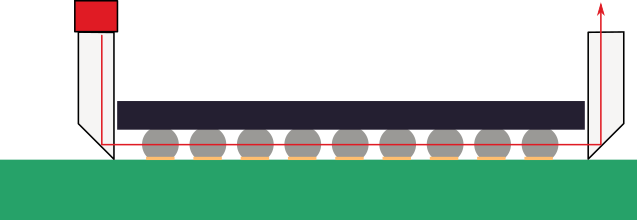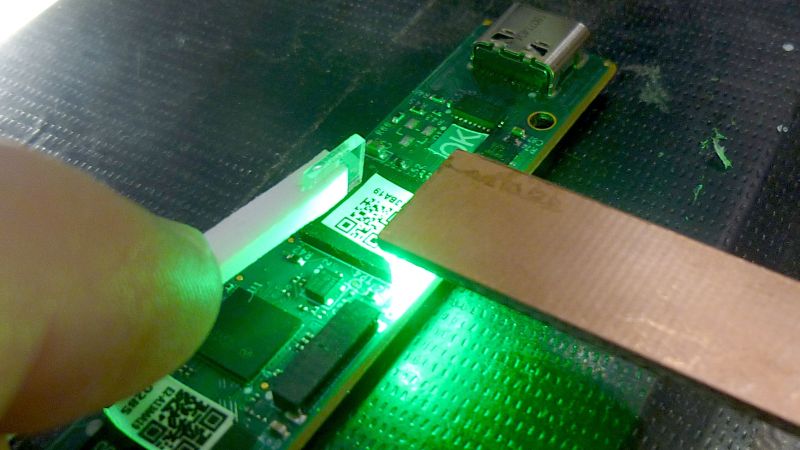Compared to through-hole construction, inspecting SMD construction is a whole other game. Things you thought were small before are almost invisible now, and making sure solder got where it’s supposed to go can be a real chore. Add some ball grid array (BGA) chips into the mix, where the solder joints are not visible by design, and inspection is more a leap of faith than objective proof of results.

Unless, of course, you put the power of optics to work, as [Petteri Aimonen] does with this clever BGA inspection tool. It relies on a pair of tiny prisms to bounce light under one side of a BGA chip and back up the other. The prisms are made from thin sheets of acrylic; [Petteri] didn’t have any 1-mm acrylic sheet on hand, so he harvested material from a razor blade package. The edge of each piece was ground to a 45-degree angle and polished with successively finer grits until the surfaces were highly reflective. One prism was affixed to a small scrap of PCB with eleven SMD LEDs in a row, forming a light pipe that turns the light through 90 degrees. The light source is held along one edge of a BGA, shining light underneath to the other prism, bouncing light through the forest of solder balls and back toward the observer.
The results aren’t exactly crystal clear, which is understandable given the expedient nature of the materials and construction employed. But it’s certainly more than enough to see any gross problems lying below a BGA, like shorts or insufficiently melted solder. [Petteri] reports that flux can be a problem, too, as excess of the stuff can crystalize between pads under the BGA and obstruct the light. A little extra cleaning should help in such cases.
Haven’t tackled a BGA job yet? You might want to get up to speed on that.

















Clever! I have also used a piece of reflective material (front surface mirror, mylar, chromed steel) held at a 45 degree angle at the edge of the IC to inspect ball compression under a stereo microscope.
Apparently, people who work with BGAs are sometimes playing with tiny balls.
If you don’t have x-ray equipment, you mother an invention.
Really clever! I do wonder what you can make out from what you see through… it sounds hard to understand anything beside major defects, no? Is that view really helping?
It really only shows major defects. Eventually it would be cool to get to the point of commercial systems like https://linkhamson.com/new-generation-optical-bga-inspection/
But my optics manufacturing skills are not on that level yet.
Where I worked back in 2003 had an Ersa BGA rework and inspection station.
The inspection station had a camera that was based on this principle, which could look through the rows of the BGA and by moving the focus, you could literally inspect each ball of the array.
It was a really nice piece of kit.
We still have and use the Ersascope system which you mention.
Ersascope demo for anyone interested: https://youtu.be/A3EIG4rxgiQ?t=75
If a design has a single BGA, a method I use to check proper reflow is to solder down the bga before any parts that connect to its IO pins. These pins all have ESD protection diodes connected to the power rails. Checking each IO against the power rails for a diode drop with a low current multimeter, you can verify proper connectivity to the pcb.
We have a winner!
Show him what he’s won.
A brand new door!
I wonder if you could put a piece of glass on a hotplate at an appropiate temperature and press the acrylic on it in 45 degree to get a quick clear surface.
I should find some acrylic and see if you can get any clear surface with heated glass.
I also (alternatively) wonder if he could have used a shaving blade to cut a thin sliver off the surface instead of the grinding. Although you’d have to make a rig to align things and hold the blade I suppose, so more effort than sanding, but perhaps usable for bulk production, who knows.
What about an linear array of multimode fiber to shoot and inspect light ? I wonder if i could make a boroscope that could see down the ball rows . I also have prisms from cdrom players somewhere that are 90degrees. Good article/gives us ideas.
I’ve been disassembling Dvd, cd-rw, drives for sometime now. The larger contraption that moves the lens back and forth inside the drive almost always has small pieces of glass, usually squarish, glued in at an angle. Varying colours: blue, yellow. Kind of a one way mirror. Neat, and hard to throw away, just in case ‘someday’ useful. Could they be used as a prism?